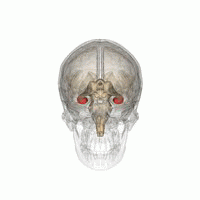
Photo from wikipedia
Immediate early genes (IEGs) are a fundamental element in the way we respond and adapt to a variety of stimuli. We have recently reported that IEG response, as measured by… Click to show full abstract
Immediate early genes (IEGs) are a fundamental element in the way we respond and adapt to a variety of stimuli. We have recently reported that IEG response, as measured by c‐Fos expression, is different between rodents and primates. Here, we further extend this analysis by assessing the expression of c‐Jun, one of the main complements of c‐Fos, under the same stimulation protocol. For this, we investigated the immunohistochemical expression of c‐Jun (and compared with that previously shown for c‐Fos) after stimulation with pentylenetetrazol in the cingulate gyrus, motor cortex, piriform cortex, inferior temporal cortex, and visual cortex of rats and marmosets (Callithrix jacchus), both male and female. Overall the immunohistochemical expression of c‐Jun was more intense but remained elevated for a shorter duration in marmosets as compared to rats. These results are in contrast to what we had previously shown for c‐Fos. Furthermore, in terms of the temporal profile, c‐Fos and c‐Jun expression occurred in a complementary manner in rats—the peak of c‐Fos expression coincided with low levels of c‐jun expression—and in a superimposed manner in marmosets—the peak of c‐Fos expression coincided with the peak of c‐Jun expression. Since Fos proteins may form dimers with Jun proteins and together control late gene expressions in the cell nucleus, this different expression profile between primates and rodents may bear meaningful impact for how the nervous system reacts and adapts to stimulation.
Journal Title: Journal of Neuroscience Research
Year Published: 2019
Link to full text (if available)
Share on Social Media: Sign Up to like & get
recommendations!